


Galaxy morphology is replete with evidence for gravitational interactions, ranging from minor, distant encounters, to violent collisions and major/minor mergers. Many of the most puzzling and exotic morphologies can be explained by interactions, and even sublimely normal galaxies, like ordinary ellipticals, have been connected to catastrophic encounters. Up to 4% of bright nearby galaxies are involved in a major interaction (Knapen & James 2009). In clusters, other types of interactions may occur, such as gas stripping and truncation of the star-forming disk. In this section, a variety of the types of morphologies that may be considered the results of external interactions are described and illustrated.
10.1. Normal versus Catastrophic Rings
The three types of rings described so far, nuclear, inner, and outer rings, are aspects of the morphology of relatively normal, undisturbed galaxies. Inner rings and pseudorings are found in more than 50% of normal disk galaxies (Buta & Combes 1996), while outer rings and pseudorings are found at the 10% level. The latter rings could be more frequent because their faintness may cause them to go undetected, which is less likely to occur for inner rings. As has been noted, nuclear rings are found at the 20% level (Comerón et al. 2010). The high abundance of these types of ring features suggests that they are mainly products of internal dynamics, and in fact all three ring types have been interpreted in terms of internal processes in barred galaxies. The main interpretation of these kinds of rings has been in terms of orbital resonances with the pattern speed of a bar, oval, or spiral density wave. Resonances are special places where a bar can secularly gather gas owing to the properties of periodic orbits (Buta & Combes 1996). Buta (1995) showed that the intrinsic shapes and relative bar orientations of inner and outer rings and pseudorings supports the resonance interpretation of the features. Schwarz (1981) suggested the outer Lindblad resonance for outer rings and pseudorings, while Schwarz (1984) suggested the inner 4:1 ultraharmonic resonance for inner rings and pseudorings, and the inner Lindblad resonance for nuclear rings. Knapen et al. (1995b) and Buta & Combes (1996) provide further insight into these interpretations.
The resonance idea may only be valid in the case of weak perturbations. In the presence of a strong perturbation, the concept of a specific resonance radius can break down, although the idea of a broad resonance region could still hold (Contopoulos 1996). Regan and Teuben (2003, 2004) argue that nuclear rings and inner rings are better interpreted in terms of orbit transitions, that is, regions where periodic orbits transition from one major orbit family to another, as in the transition from the perpendicularly-aligned x2 family to the bar-aligned x1 family (Contopoulos & Grosbol 1989).
Normal rings have also been interpreted in terms of "invariant manifolds" which emanate from the unstable L1 and L2 Lagrangian points in the bar potential (Romero-Gómez et al. 2006, 2007; Athanassoula et al. 2009a, b>). This approach has also had some success in predicting the shapes and orientations of inner and outer rings, such as the R1, R'1, R1R'2, and R'2 morphologies shown in Figure 14 and Figure 15. A morphology called "rR1", which includes an oval inner ring and a figure eight-shaped R1 ring (see NGC 1326 in Figure 15), is especially well-represented by this kind of model. The manifolds are tubes which guide orbits escaping the L1 and L2 regions. Note that in this interpretation, outer rings are not necessarily associated with the OLR (Romero-Gómez et al. 2006).
Although the vast majority of the ring-like patterns seen in galaxies are probably of the resonance/orbit-transition/invariant-manifold type, other classes of rings are known that are likely the result of more catastrophic processes, such as galaxy collisions. Figure 27 shows resonance rings in comparison to three other types: accretion rings, polar rings, and collisional rings (the latter commonly referred to as "ring galaxies"). The three accretion rings shown, in Hoag's Object (Schweizer et al. 1987), IC 2006 (Schweizer et al. 1989), and NGC 7742 (de Zeeuw et al. 2002) are thought to be made of material from an accreted satellite galaxy. For IC 2006 and NGC 7742, the evidence for this is found in counter-rotation: the material in the rings counter-rotates with respect to the material in the rest of the galaxies. In Hoag's Object and IC 2006, the accreting galaxy is a normal E system.
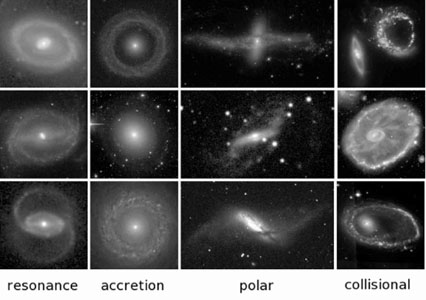 |
Figure 27. Different classes of ring phenomena seen in galaxies (top to bottom): Column 1 - NGC 3081, NGC 1433, and UGC 12646. Column 2 - Hoag's Object, IC 2006, and NGC 7742; Column 3 - NGC 4650A, ESO 235-58, and NGC 660; Column 4 - Arp 147, the Cartwheel, and the Lindsay-Shapley ring. All images are from the dVA except Arp 147. |
Polar rings are also accreted features except that the accreting galaxy is usually a disk-shaped system, most often an S0 (Whitmore et al. 1990). In these cases, the accreted material comes in at a high angle to the plane of the disk. The configuration is most stable if the accretion angle is close to 90°, or over the poles of the disk system. This limits the ability of differential precession to cause the ring material to quickly settle into the main disk. The polar feature can be a ring or simply an inclined and extended disk. Whitmore et al. (1990) presented an extensive catalogue of probable and possible polar ring galaxies.
The main example illustrated in Figure 27 is NGC 4650A, where the inner disk component is an S0. Galaxies like NGC 4650A have generated considerable research because polar rings probe the shape of the dark halo potential (e. g., Sackett et al. 1994). The galaxies are also special because the merging objects have retained their distinct identities, when most mergers lead to a single object. Brook et al. (2008) link the misaligned disks of polar ring galaxies to the process of hierarchical structure formation in a cold dark matter scenario.
While polar rings are most easily recognizable when both disks are nearly edge-on to us, cases where one or the other disk is nearly face-on have also been recognized. One example, ESO 235-58 (Buta & Crocker 1993) is shown in the middle-right panel of Figure 27. In this case, the inner component is almost exactly edge-on and shows a planar dust lane, and is likely a spiral rather than an S0. The ring component is inclined significantly to the plane of this inner disk but may not be polar. The faint outer arms in this component caused ESO 235-58 to be misclassified as a late-type barred spiral in RC3. Spiral structure in polar disks has been shown to be excitable by the potential of the inner disk, which acts something like a bar (Theis, Sparke, & Gallagher 2006).
An example where the main disk is seen nearly face-on is NGC 2655 (Sparke et al. 2008). In this case, the polar ring material is seen as silhouetted dust lanes at an uncharacteristic angle to the inner isophotes. NGC 2655 also shows evidence of faint shells/ripples, indicative of a recent merger (section 10.3.3). Sil'chenko & Afanasiev (2004) have discussed NGC 2655 and other similar examples of inner polar rings in terms of the triaxiality of the potential.
Also illustrated in Figure 27 is NGC 660, which was listed as a possible polar ring galaxy by Whitmore et al. (1990). Like ESO 235-58, NGC 660 has an aligned dust lane in its inner disk component, which thus is likely to be a spiral, not an S0. The extraplanar disk is actually far from polar, being inclined only 55° (van Driel et al. 1995). A recent study of massive stars in the ring is given by Karataeva et al. (2004).
Collisional ring galaxies (Arp 1966; Appleton & Struck-Marcell 1996) are thought to be cases where a larger galaxy suffers a head-on collision with a smaller galaxy down its polar axis. The collision causes an expanding density wave of massive star formation, and multiple rings are possible. Three examples are shown in Figure 27. Theys & Spiegel (1976) have discussed various classes of ring galaxies. Arp 147 (Arp 1966) is an example of type "RE", referring to a sharp elliptical ring with an empty interior. The Cartwheel (Higdon 1995) and the Lindsay-Shapley ring (Arp & Madore 1987) are examples of type "RN", meaning an elliptical ring with an off-center nucleus. Not shown in Figure 27 is a third category called "RK", where a single, large knot lies on one side of the ring, making the system very asymmetric.
Madore, Nelson, & Petrillo (2009) have published a comprehensive atlas of all known likely collisional ring galaxies, many taken from the catalogue of Arp & Madore (1987). Based on this study, only 1 in 1000 galaxies is a collisional ring galaxy. For entry, the Madore et al. atlas requires at least two objects in the immediate vicinity of the ring that might plausibly be the intruder galaxy. Most of the rings are not in cluster environments, however. The atlas also brings attention to several double-ring collisional systems, which have been predicted by numerical simulations (see Struck 2010 for a review). The unusual radial "spokes" in the Cartwheel, a feature not seen in any other collisional ring galaxy, could be related to interactive accretion streams (Struck et al. 1996).
Romano, Mayya, & Vorobyov (2008) present images of several ring galaxies that show the pre-collision stellar disk. They also show that rings are generally delineated by blue knots and that the off-centered nuclei are usually more yellow in color. In addition, some of the companion galaxies show diffuse asymmetric outer light suggesting that they are being stripped.
Figure 27 shows that accretion rings can account for some of the rings seen in nonbarred galaxies. Buta & Combes (1996) argue that a bar is an essential element in resonance ring formation. ESO 235-58 shows that a polar ring-related system can resemble a ringed, barred galaxy. The three collisional rings are all very distinctive from the others.
10.2. Environmental Effects on Star-Forming Disks
Galaxy clusters are excellent laboratories for detecting the effects of environment on galaxy morphology and structure. Frequent mergers and environmental conversion of spirals into S0s are thought to be at the heart of the morphology-density relation, where early-type galaxies dominate cluster cores, and spirals and irregulars are found mainly in the outer regions (Dressler 1980; van der Wel et al. 2010).
The issue of environmental effects has a direct bearing on how we might interpret the Hubble sequence. For example, the continuity of galaxy morphology certainly seems apparent from the discussions in previous sections of this review. The Hubble sequence E-S0-Sa-Sb-Sc-I appears physically significant when total colors, mean surface brightnesses, and HI mass-to-blue light ratios are considered, and the way features are recognized in the classification systems also favors the continuity. Morphological continuity does not, however, automatically imply that the galaxy types are in fact ordered correctly. For example, although Hubble placed S0s as a transition type between elliptical galaxies and spirals, this placement has been questioned by van den Bergh (1998, 2009a). Based on a statistical analysis of types given in the RSA, van den Bergh showed that S0 galaxies are typically 0.8-1.0 mag less luminous than E and Sa galaxies, implying that S0 galaxies, on the whole, cannot really be considered intermediate between E and Sa galaxies. 4 The preponderance of S0 galaxies in clusters led to the early suggestion (e.g., Spitzer & Baade 1951; Gunn & Gott 1972; Moore et al. 1996) that some type of external environmental interaction was responsible for stripping a spiral galaxy of its interstellar medium. If this actually occurred, then, as suggested by van den Bergh (2009a), this could imply that S0 galaxies have lost a substantial fraction of their spiral mass due to interactions. Alternatively, van den Bergh (2009b) argues that stripping of a lower luminosity, late-type spiral should be easier than stripping of a higher luminosity, early-type spiral, which could also account for the luminosity difference. In an examination of the environment of S0 galaxies, van den Bergh (2009b) found no significant difference in the average luminosities, flattenings, or distribution of S0 subtypes in clusters, groups, or the field, indicating that some S0s develop as a result of internal effects, such as the influence of an active galactic nucleus.
Barway et al. (2011) noted that lower luminosity S0s have a higher bar fraction than higher luminosity S0s (83% versus 17%), suggesting that the two groups form in different ways (see also Barway et al. 2007). These authors suggest that faint S0s are stripped late-type spirals, which are known to have a high bar fraction (Barraza et al. 2008).
Environmental effects in clusters do not always have to involve drastic transformations in morphology. Sometimes the effects are more subtle. Figure 28 shows several spiral galaxies that are also members of the Virgo Cluster. These galaxies highlight processes that affect the star-forming disk while leaving the older stellar disk relatively unaffected. NGC 4580 and 4689 are galaxies having a patchy inner disk and a smooth outer disk, called "Virgo types" by van den Bergh et al. (1990). These objects suggest that the environment of such galaxies has somehow truncated the star-forming disk, with a greater concentration of truncated disks toward the cluster core. Similar results are obtained from observations of the HI gas disks of Virgo cluster galaxies (e.g., Giovanelli & Haynes 1985; Cayatte et al. 1994; Chung et al. 2009).
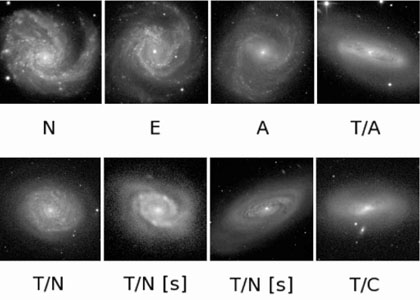 |
Figure 28. Blue light morphologies of eight
Virgo Cluster spirals having different
Koopmann & Kenney
(2004)
H |
Koopmann & Kenney
(2004)
summarize the results of an extensive survey
of H emission from
Virgo Cluster galaxies, and identify
different categories of environmentally-influenced star formation
characteristics based on
H
emission from
Virgo Cluster galaxies, and identify
different categories of environmentally-influenced star formation
characteristics based on
H imaging. The blue
light images of examples of each category are included in
Figure 28, and
show how the subtleties are manifested in regular morphology. Using a
sample of isolated spiral galaxies to define "normal" star formation,
Koopmann and Kenney defined several categories of Virgo spiral galaxy
star-forming disks: Category "N" refers to disks whose star formation
is within a factor of three of the normal levels. "E" cases have star
formation enhanced by more than a factor of three compared to normal.
"A" cases are "anemic" spirals (section 6.4)
having star formation
reduced by more than a factor of 3 compared to normal. "T/N" refers
to galaxies where the star-forming disk is sharply cut off, but inside
the cutoff, the star formation levels are normal (the [s] means
truncation is severe). One of these, NGC 4580, is so unusual that
Sandage & Bedke (1994)
classify it as Sc(s)/Sa, where the Sc part is
the inner disk and the Sa part is the outer disk. In "T/A galaxies",
the inner star-formation is at a low level, as in anemic cases, while
in "T/C" galaxies, most of the star formation is confined within the
inner 1 kpc. Koopmann and Kenney found that the majority of
Virgo Cluster spiral galaxies have truncated
star-forming disks.
imaging. The blue
light images of examples of each category are included in
Figure 28, and
show how the subtleties are manifested in regular morphology. Using a
sample of isolated spiral galaxies to define "normal" star formation,
Koopmann and Kenney defined several categories of Virgo spiral galaxy
star-forming disks: Category "N" refers to disks whose star formation
is within a factor of three of the normal levels. "E" cases have star
formation enhanced by more than a factor of three compared to normal.
"A" cases are "anemic" spirals (section 6.4)
having star formation
reduced by more than a factor of 3 compared to normal. "T/N" refers
to galaxies where the star-forming disk is sharply cut off, but inside
the cutoff, the star formation levels are normal (the [s] means
truncation is severe). One of these, NGC 4580, is so unusual that
Sandage & Bedke (1994)
classify it as Sc(s)/Sa, where the Sc part is
the inner disk and the Sa part is the outer disk. In "T/A galaxies",
the inner star-formation is at a low level, as in anemic cases, while
in "T/C" galaxies, most of the star formation is confined within the
inner 1 kpc. Koopmann and Kenney found that the majority of
Virgo Cluster spiral galaxies have truncated
star-forming disks.
The idea is that the interstellar medium (ISM) of a cluster galaxy can interact with the intra-cluster medium (ICM), stripping the ISM (via ram pressure; Gunn and Gott 1972) but leaving the stellar disk intact. Truncated gas and star-forming disks result because ram-pressure stripping is more severe in the outer parts of galaxies (e. g., Book and Benson 2010 and references therein). In Virgo, most galaxies with truncated star-forming disks have relatively undisturbed stellar disks and normal to slightly enhanced inner disk star formation rates, suggesting that ICM-ISM stripping is the main mechanism in the reduction of their star formation rates. The cases found to have relatively normal or enhanced star formation rates are preferentially located in the outer parts of the cluster and likely have never visited the core region. Only galaxies which go near the center get significantly stripped. However, tidal effects also contribute to morphological changes. Several galaxies, including many of the T/C class, display peculiarities consistent with tidal effects, such as nonaxisymmetric circumnuclear star formation, shell features (e.g., NGC 4424 in Figure 28), and enhanced inner star formation rates.
A recent study by
Yagi et al. (2010)
provides dramatic and clear
evidence of disk gas stripping in galaxies thought to be relatively new
arrivals to the core region of the Coma Cluster. Using deep
H imaging, these authors detected ionized gas in clouds that are mostly
outside the main disk of a dozen Coma galaxies. Three distinct
morphologies of the distributions of these clouds were found: (1)
connected clouds that blend with disk star formation; (2) long,
connected lines of clouds that extend from a central gas knot but are
not related to the disk light; and (3) clouds completely detached from
the main disk. Examples of these categories are illustrated in
Figure 29. Yagi et al. interpret them in terms
of an evolutionary gas-stripping sequence where category (1) galaxies are in
an earlier phase of stripping while the category (3) galaxies are in
the most advanced phase. It is likely that large disk galaxies in Coma
would be completely stripped eventually because of the cluster's high
ICM density and broad velocity distribution. The same process seen
in Coma likely occurs in Virgo but is only partial for the large
spirals owing to the lower ICM density and velocities in Virgo
(Koopmann & Kenney
2004).
imaging, these authors detected ionized gas in clouds that are mostly
outside the main disk of a dozen Coma galaxies. Three distinct
morphologies of the distributions of these clouds were found: (1)
connected clouds that blend with disk star formation; (2) long,
connected lines of clouds that extend from a central gas knot but are
not related to the disk light; and (3) clouds completely detached from
the main disk. Examples of these categories are illustrated in
Figure 29. Yagi et al. interpret them in terms
of an evolutionary gas-stripping sequence where category (1) galaxies are in
an earlier phase of stripping while the category (3) galaxies are in
the most advanced phase. It is likely that large disk galaxies in Coma
would be completely stripped eventually because of the cluster's high
ICM density and broad velocity distribution. The same process seen
in Coma likely occurs in Virgo but is only partial for the large
spirals owing to the lower ICM density and velocities in Virgo
(Koopmann & Kenney
2004).
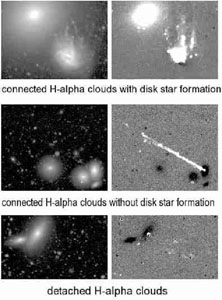 |
Figure 29. Three galaxies in a possible
evolutionary stripping sequence in the
Coma Cluster. The images and categories are from
Yagi et al. (2010).
The left frames are B-band images in units of mag
arcsec-2, while the right frames are net
H |
10.3. Interacting and Peculiar Galaxies
10.3.1. Tidal Tails, Arms, and Bridges
It is perhaps fitting that the first major spiral galaxy discovered was in the interacting pair M51 (section 2). Numerical simulations (Salo & Laurikainen 2000a, b) have shown that both parabolic and bound passages of the companion, NGC 5195, can explain the observed morphology and other characteristics of the system. It turns out that M51 defines a class of interacting systems known as M51-type pairs. Figure 30 shows an example in the pair NGC 2535-6. In each case, the larger component has a strong two-armed spiral, with one arm appearing "drawn" to the smaller companion. An extensive catalogue of M51-type pairs is provided by Jokimaki et al. (2008).
 |
Figure 30. Interacting and peculiar galaxies. The galaxies are (left to right): Row 1: NGC 5485 (SDSS), 4370 (SDSS), 5216/18 (A. Block), 4676 (Hubble Heritage), and 2535-6 (SDSS); Row 2: NGC 2865, 474, 4038-9, 3690, and 6240, all B except NGC 474, which is a 3.6µm image (section 12). |
Other distant encounters can produce tidal tails or bridges of material between galaxies (top row, Figure 30). NGC 4676, also known as the "Mice," is a pair of strongly interacting galaxies where a very extended tidal tail has formed in one component. The strongly-interacting pair NGC 5216/18 has developed a bright connecting bridge of material, and each component shows tidal tails. The evolution of this system, and the role of encounters on bar formation, is described by Cullen et al. (2007).
Figure 30 also shows several examples of morphologies that may result from minor mergers of a small galaxy with a more massive, pre-existing elliptical galaxy. Bertola (1987) brought attention to the unusual class of dust-lane ellipticals, where an otherwise normal elliptical galaxy shows peculiar lanes of obscuring dust. It was de Vaucouleurs's personal view that "if an elliptical shows dust, then it's not an elliptical!" However, Bertola showed that an unusual case like the radio elliptical galaxy NGC 5128, where a strong dust lane lies along the minor axis of the outer light distribution, is simply the nearest example of a distinct class of objects. Further study showed that dust-lane ellipticals come in several varieties. The minor axis dust lane type appears most common, but cases of alignment along the major axis of the outer isophotes (major axis dust lanes) as well as cases of misalignment are also known (see the upper left panels of Figure 30). The origin of these very regular dust lanes is thought to be a merger of a gas-rich companion (e.g., Oosterloo et al. 2002). The regularity of the dust lanes suggests that the mergers are in advanced states.
The two lower left frames of Figure 30 show examples of galaxies having "shells,", or faint, arc-shaped brightness enhancements of varying morphology. They were first discovered on deep photographs by Malin (Malin & Carter 1980), and appeared to be associated mainly with elliptical galaxies. In fact, the first examples, NGC 1344 and 3923, are classified in catalogues as ordinary ellipticals because the shells are not detectable on photographs of average depth. Once the class was recognized, a detailed search led to other examples which were listed by Malin & Carter (1980, 1983). The term "shells" implies a particular three-dimensional geometry that Schweizer & Seitzer (1988) argued imposes a prejudice on the interpretation of the structures. They proposed instead the alternate term "ripples," which implies less of a restrictive geometry.
The explanation of shell/ripple galaxies is one of the great success stories in galactic dynamics (see review by Athanassoula & Bosma 1985). Shells are thought to be remnants of a minor merger between a massive elliptical and a lower mass disk-like galaxy. The main requirements are that the disk-shaped galaxy be "cold", or lack any random motions, and that the potential of the elliptical galaxy should be rigid, meaning the elliptical is much more massive than its companion. The smaller galaxy's stars fall into the center of the galaxy and phase wrap, or form alternating outward-moving density waves made of the disk galaxy's particles near the maximum excursions of their largely radial orbits in the rigid potential. Many, but not all, of the main properties of shell Es can be explained by this model. Other issues concerning shell galaxies are reviewed by Kormendy and Djorgovski (1989).
Taylor-Mager et al. (2007; see their Figure 2) have proposed a simple classification of interacting systems that highlights different interaction classes. A pre-merger (type pM) includes two interacting galaxies that are sufficiently far apart to suffer little apparent distortion. A minor merger (mM) is two galaxies showing evidence of merging, but one component is much smaller than the other. A major merger (M) has two comparable brightness galaxies in the process of merging, while a merger remnant (MR) is a state sufficiently advanced that the merging components are no longer distinct.
10.3.4. Ultra-Luminous Infrared Galaxies
Related to interacting systems are the infrared-bright galaxies
first identified by
Rieke & Low (1972)
based on 10µm photometry.
From studies based on the Infrared Astronomical Satellite (IRAS),
Sanders & Mirabel
(1996)
classified a galaxy as a "luminous infrared
galaxy" (LIRG) if its luminosity in the 8-1000µm range is
between 1011 and 1012
L . If the
luminosity in the same wavelength range exceeds 1012
L
. If the
luminosity in the same wavelength range exceeds 1012
L , then
the object is
called an "ultra-luminous infrared galaxy" (ULIRG). Detailed studies
have shown that at high redshifts, LIRGS and ULIRGS are a dominant
population of objects (see discussion in
Pereira-Santaella et
al. 2010).
, then
the object is
called an "ultra-luminous infrared galaxy" (ULIRG). Detailed studies
have shown that at high redshifts, LIRGS and ULIRGS are a dominant
population of objects (see discussion in
Pereira-Santaella et
al. 2010).
The morphologies of nine ULIRGS were studied using HST B and I-band images by Surace et al. (1998). Their montage of six of these objects is shown in Figure 31. In every case there are clear signs of interactions, and all are likely linked to mergers or mergers in progress. Several, like Mk 231, have bright Seyfert nuclei. Arribas et al. (2004) obtained extensive imaging of local LIRGS, and found a similar high proportion of strongly interacting and merging systems.
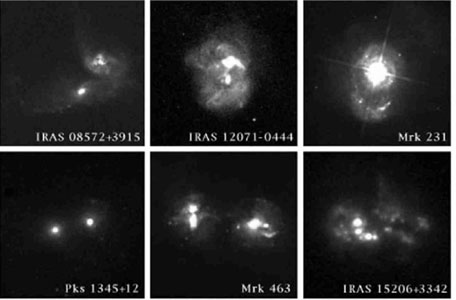 |
Figure 31. The morphologies of six "ultra-luminous infrared galaxies" from HST optical/near-IR imaging (Surace et al. 1998). These images are not in units of mag arcsec-2. |
The merger rate is considered one of the most important parameters for understanding galaxy evolution. It has been difficult to estimate, and issues connected with it are discussed by Jogee et al. (2009; see also Conselice 2009). A merger is considered major if it involves a companion ranging from 1/4 to approximately equal mass to the main galaxy. A major merger of two spiral galaxies can destroy both disks and lead to an r1/4 law profile remnant through violent relaxation. Minor mergers involve companions having 1/10 to 1/4 the mass of the main galaxy. Both types of mergers, while in progress, can lead to many specific morphological features such as highly distorted shapes, tidal tails and bridges, shells and ripples, and warps. Even some bars and spiral patterns are thought to be connected to interactions, and especially galaxies with a double nucleus are thought to be mergers. As discussed in section 10.1, mergers or collisions may also be at the heart of rare morphologies such as ring and polar ring galaxies. Using visual classifications of merger types, Jogee et al. (2009) estimate that 16% of high mass galaxies have experienced a major merger, while 45% have experienced a minor merger, during the past 3-7Gyr (z = 0.24-0.80).
A warp is an apparent bend or slight twist in the shape of the disk of a spiral galaxy (see Sellwood 2010 and references therein). In a warp, stars and gas clouds move in roughly circular orbits, but the orientation of these orbits relative to the inner disk plane changes with increasing radius. Warps are most easily detected in edge-on galaxies because the bending of the outer orbits makes the galaxy look like an integral sign. Although often most pronounced in an HI map, warps can be seen in ordinary optical images of edge-on galaxies. Figure 32 shows three galaxies having strong optical warping of the disk plane. In two of the galaxies, the bright inner disk is unwarped, while a fainter and thicker outer disk zone is twisted relative to the inner disk. In UGC 3697, the warping is exceptionally visible. In general, optical warping is less severe than HI warping.
 |
Figure 32. Three galaxies showing strong optical disk warping. Left to right: NGC 4762 (B), NGC 4452 (SDSS), UGC 3697 (Internet Encyc. of Science) |
Warping is a very common aspect of spiral galaxies (e.g., Binney 1992) and has been interpreted in terms of perturbations (gaseous infall or interactions) that trigger bending instabilities (e.g., Revaz & Pfenniger 2007). Garcia-Ruiz, Sancisi, & Kuijken (2002) estimated HI warp angles, the angle between the inner disk plane and the assumed linear warping zone, to range from nearly 0° to more than 30°. A useful summary of previous warp studies is provided by Saha et al. (2009), who examine warp onset radii in mid-IR images. The theory of warps is reviewed by Sellwood (2010).
10.5. The Morphology of Active Galaxies
The morphology of active galaxies (also called "excited" galaxies by van den Bergh 1998) is important to consider because of a possible link between morphological features and the fueling of the active nucleus. Early studies showed a preponderance of ring, pseudoring, and bar features in Seyfert galaxies that suggested the link was bar-driven gas flow (Simkin, Su, & Schwarz 1980). Several examples of the morphology of Seyfert and other active galaxies are shown in Figure 33. The activity classifications are based mainly on spectroscopy, not on morphology, and are described by Veron-Cetty & Veron (2006).
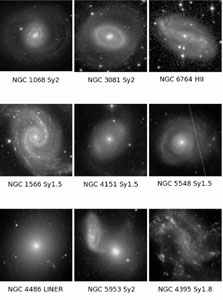 |
Figure 33. Images of nearby active galaxies, dVA B-band except for NGC 5548 and 5953, which are SDSS. The activity classification is from Veron-Cetty & Veron (2006). |
A detailed study of active galaxy morphologies by
Hunt & Malkan (1999)
provided similar results to the early studies. These authors examined
the morphologies of a large sample of galaxies selected on the basis of
their 12µm emission, and found that outer rings and inner/outer
ring combinations are 3-4 times higher in Seyfert galaxies than in
normal spirals. In contrast, bars were found to occur with the same
frequency ( 69%) in
Seyferts as in normal spirals, while for
HII/starburst galaxies, the frequency was much higher (> 80%).
Although outer rings are found mostly in barred galaxies, bars do not
promote the nuclear activity of Seyfert galaxies.
Hunt & Malkan (1999)
interpret this inconsistency in terms of timescales: it takes roughly
3 × 109 yr for a closed outer ring to form, a timescale
during which a bar may weaken or dissolve. Because of this, a high ring
frequency in Seyferts would indicate an advanced evolutionary state.
Related to the same issue,
Comerón et al. (2010)
found that
nuclear rings do not correlate with the presence of nuclear activity.
69%) in
Seyferts as in normal spirals, while for
HII/starburst galaxies, the frequency was much higher (> 80%).
Although outer rings are found mostly in barred galaxies, bars do not
promote the nuclear activity of Seyfert galaxies.
Hunt & Malkan (1999)
interpret this inconsistency in terms of timescales: it takes roughly
3 × 109 yr for a closed outer ring to form, a timescale
during which a bar may weaken or dissolve. Because of this, a high ring
frequency in Seyferts would indicate an advanced evolutionary state.
Related to the same issue,
Comerón et al. (2010)
found that
nuclear rings do not correlate with the presence of nuclear activity.
The study of Hunt & Malkan (1999) used mostly RC3 classifications to deduce the bar fraction in active galaxies. These visual classifications are based on blue light images and hence dust could effectively obscure some bars. Knapen et al. (2000) used high resolution near-IR images of well-defined samples and quantitative bar detection methods to deduce that bars are more frequent in Seyfert galaxies than in a control sample of non-active galaxies: 79% ± 7.5% versus 59% ± 9% (see also Laine et al. 2002). Laurikainen, Salo, & Buta (2004) came to a similar conclusion for 180 galaxies in the OSUBSGS, based on near-IR H-band images. The former studies used ellipse fits to identify bars, while Laurikainen et al. used Fourier analysis.
McKernan, Ford, & Reynolds (2010) also consider outer rings and pseudorings as probes of models of AGN fueling from interactions and mergers. The idea is that a closed outer ring takes a long time to form and is very fragile, being sensitive to interactions and changes in the bar pattern speed (e.g., Bagley et al. 2009). An interaction can change a closed outer ring into a pseudoring and could possibly destroy the ring. Thus, rings are probes of the interaction history of active galaxies. McKernan et al. found no difference between the AGN found in ringed galaxies and those found in galaxies without rings. But in those with rings, recent interactions can be ruled out and activity may be tied to short-term internal secular evolutionary processes.
Bahcall et al. (1997) presented HST images of 20 luminous, low redshift quasars observed with a wide V-band filter. Figure 34 is reproduced from their paper and shows images of the host galaxies after removal of most of the quasar light. The images show a variety of morphologies, including ellipticals, interacting pairs, systems with obvious tidal disturbances, and normal-looking spirals. An example of the latter is PG 1402+261 (z = 0.164), which is type (R'1)SB(rs)a based partly also on the image shown in Figure 7 of Bahcall et al. Based on the number of hosts showing signs of interactions, as well as the number of companions, Bahcall et al. conclude that interactions may trigger the quasar phenomenon.
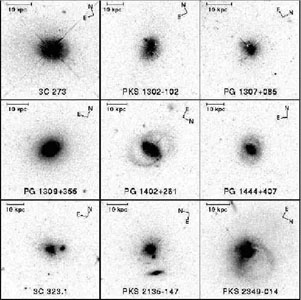 |
Figure 34. The morphologies of the host galaxies of nine nearby quasars, from Bahcall et al. (1997). These images are not in units of mag arcsec-2. |
10.6. The Morphology of Brightest Cluster Members
Matthews, Morgan, & Schmidt (1964) observed the optical morphologies of the radio sources identified with the brightest members of rich galaxy clusters. They found that the most common form was what Morgan (1958) called a "D" galaxy, meaning a galaxy having an elliptical-like inner region surrounded by an extensive envelope (see discussion in van den Bergh 1998). Although these superficially resembled Hubble's S0s, none were found having a highly-elongated shape, implying that the galaxies are not as highly flattened as typical S0s. Another characteristic of the cluster D galaxies was their very large linear size and exceptional luminosity, much larger than a typical cluster member. To denote these extreme objects in the Morgan system, the prefix c was added as in the old classification of supergiant stars. Even today, Morgan's notation "cD" is used to describe these supergiant galaxies which are generally considered outside the scope of the Hubble system.
The most detailed study of the photometric properties of brightest cluster members (BCMs) was made by Schombert (1986, 1987, 1988; see also various references therein). The main BCM types Schombert considered were gE (giant ellipticals), D, and cD, distinguished mainly from the appearance of profile shape. D galaxies are larger and more diffuse with shallower profiles than gE galaxies, while a cD galaxy is the same as a D galaxy but with a large extended envelope (Schombert 1987). cD envelopes can extend to 500 kpc or more. Kormendy & Djorgovski (1989) argue that only cD galaxies are sufficiently physically distinct from ellipticals to merit being a separate class, and recommended that the "D" class not be used.
Two cD galaxies and two gE galaxies are shown in Figure 35. To give an idea of the scale of these objects, the vertical dimension of the frames corresponds to 201, 232, and 132 kpc for (left to right) UGC 10143 (A2152), NGC 4874/89 (A1656), and NGC 6041 (A2151), respectively. The cD classification of NGC 4874 is due to Schombert (1988), and one can see in Figure 35 that it is much larger and has a shallower brightness profile than nearby NGC 4889. The cD envelope is detected as an excess of light in the outer regions relative to a generalized brightness profile, and may not even be the light that leads to the visual classification of cD.
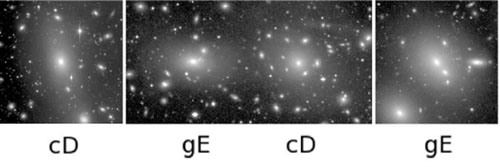 |
Figure 35. Deep images of the brightest members of three rich galaxy clusters (left to right): UGC 10143 in A2152 (R-band), NGC 4889 (left) and 4874 (right) in A1656 (B-band), and NGC 6041 (R-band) in A2151. The images of UGC 10143 and NGC 6041 are from Blakeslee (1999), while that of NGC 4874-89 is from the dVA. |
Based on structural deviations such as the large radii, shallow profile slopes, and bright inner regions, Schombert (1987) concluded that BCMs fit well with the predictions of merger simulations, including accretion and "cannibalism" of smaller cluster members. Properties of cD envelopes (as separated photometrically from the parent galaxy) may suggest a stripping process for their formation (Schombert 1988).
As noted in section 5.1, many BCMs in RC3 received the classification E+, suggesting that the characteristic brightness profiles give a hint of an envelope interpreted as an incipient disk. The distribution of axial ratios of cDs actually is flatter on average than normal ellipticals (Schombert 1986), but it is not clear that the perceived envelopes in BCM E+ galaxies are actually as flattened as a typical disk. A local example of a gE galaxy is M87, classified as type E+0-1 by de Vaucouleurs.
4 In contrast to van den Bergh's study of RSA S0 galaxies, Laurikainen et al. (2010) found that the absolute Ks-band magnitudes of a well-defined sample of S0s are similar to those of early-type spirals in the OSUBSGS sample. The sample was mostly drawn from RC3 and includes some galaxies classified as ellipticals in RC3 and as S0s in the RSA (see section 12). Back.